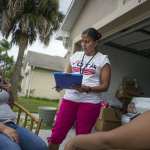Though former President Donald Trump handily won the Electoral College vote, his popular vote margin was one of the slimmest in history. But even with that, almost every county in the country got more red this cycle.
Two trends are emerging: Trump failed to make significant inroads with White women voters despite sizable gains across the board. He did make small gains among Latina voters, even as they overwhelmingly supported Democrats compared with Latino men.
Results in the Atlanta suburbs — one of the only places in the country where Harris made gains on Biden — and in Maricopa County, Arizona, which split for Trump this cycle after backing Biden in 2020, offer some clues about what happened and the work that lies ahead for both parties.
In Maricopa, Trump’s gains among Latinx voters helped flip the state’s largest county in his favor.
Maricopa, which includes the city of Phoenix and the surrounding metro area, shifted in Trump’s favor by 5.8 points compared with Biden’s performance there in 2020. About two-thirds of the state’s voters live in the country, as do more than half of all Latinx voters in the state.
Biden’s razor-thin victory in Arizona — he was the first Democratic presidential candidate to win this county since 1948 — was driven by a 24-point advantage among Latinx voters in that state. Exit polls this cycle suggest that gap may have narrowed to as little as 10 percent.
In Maricopa County precincts where more than 50 percent of registered voters are Hispanic, an analysis by Equis Research found that support for Trump grew by 12 points since 2016, less than the 20-plus point shifts seen in heavily-Latinx precincts in Florida but still decisive in this key battleground.
Teasing out exactly which groups of Latinx voters backed Trump will take some time, but post-election polling widely suggests that Trump’s gains were more sizable among Latinos than Latinas, even as the latter group did inch to the right.
Latinx voters consistently cited the state of the economy as their number one issue, ranking the cost of living and the cost of housing as top concerns, even as they also recorded high rates of support for restoring reproductive rights after Trump’s Supreme Court appointments ended federal abortion rights. One Republican strategist who worked to oppose the constitutional amendment to enshrine abortion rights in the state constitution said the success of the measure — fueled by support among many conservatives and many Latinx voters — illustrates how much the economy was top of mind even for voters who supported liberal policies backed by Harris.
In this county, 1.2 million voters backed the amendment, compared with the 1.05 million that backed Trump.
“For working-class Latinos who are not paying too much attention, it’s the difference in how much they remember paying at the grocery store when Trump was in office compared to now. It’s how much they remember paying at the pump,” said Mayra Rodriguez, the state director for Moms for Arizona, a conservative political group.
Rodriguez said that the economy helped chip away at Democrats’ support among Latinas, who in many Latinx families take on the role of grocery shopping and have seen firsthand the toll of inflation on their families’ budgets. But, Rodriguez said, the voters who swung to Trump aren’t necessarily permanently in the GOP camp now.
“These voters will go back to the Democratic Party if Republicans don’t deliver on Trump’s promises, which were many,” Rodriguez said.
The day-to-day reality of inflation made it challenging for the Harris campaign to communicate with voters about the successes of the Biden administration on job creation and health care costs, said Raquel Terán, a longtime Arizona organizer and former chair of the Arizona Democratic Party.
“You have a campaign that wants to talk about how good the economy is when people — what they see — is that it costs so much to have their basic goods,” said Terán, who ran unsuccessfully in the Democratic primary to represent Arizona’s 3rd District, anchored in Phoenix. “We should have — I wish that there was a stronger recognition of that pain.”
Inflation and the high cost of housing impacted voters across the board, but Latinx voters were more likely to feel the strain, according to an analysis from the UCLA Latino Policy and Politics Institute. The median household income of Latinx voters in Arizona is $12,000 less than that of White residents. They’re also less likely to own a home, and the proportion of Latinx voters living in overcrowded homes is almost twice that of the overall rate in the state.
She argued that one lesson for Maricopa’s election results is that Democratic candidates who related to voters’ personal struggles found success. She pointed to Anna Hernandez, who left her state Senate seat to run a progressive campaign for Phoenix city council, and Ruben Gallego, a Democrat who got nearly as many votes as Trump did in the state and will become Arizona’s first Latino U.S. senator.
-
Read Next:
“I know how hard you’re working, where your wages just haven’t kept up with costs,” Gallego said in an April ad, looking directly at the camera. “And that’s not your fault.” Hernandez leaned on her working-class background to focus on housing affordability and homelessness, and her personal story relating to police violence.
Incidentally, Gallego backed one of Hernandez’s opponents. Hernandez still won 53 percent of the vote in a four-way race for her district, which covers west and central Phoenix. It was a decisive win for a progressive candidate, who leaned into economic issues but also promised to push back on GOP immigration policies, fight for clear air and who, in the state Senate, pushed back against the banning of books that mentioned gender fluidity or trans identity.
“Housing, homelessness, public safety, affordability — these were the things that were top of mind for them,” Hernandez said in an interview with a local news outlet. “I feel like on a national level, we got away from those kitchen table issues. For me, it was so important to talk about those.”
Even as much of the focus on Maricopa became about the presidential race, voters in this county were also weighing in on the race for county schools superintendent, where the Republican candidate leaned heavily on the “parental rights” messaging that has dominated Republican politics in recent years. Republican Shelli Boggs told voters that if elected, she would “never tolerate any attempt to bring the radical policies of Critical Race Theory, Diversity/Equity/Inclusion, Gender Studies, or any other ‘woke academic policy’ into our classrooms.” Boggs also said she would oppose the inclusion of transgender girls on girls sports teams.
Boggs’ campaign helped amplify messages from Trump’s campaign that Democrats’ policies supporting inclusivity in schools were a threat to their children, and an affront to parents’ power.
Rodriguez said her group worked to get this messaging in front of moms, including Latinas. She said the state of the economy drove Trump’s victory, but said she believes that messaging targeting parents on these issues helped bolster Trump. Boggs won with close to 52 percent of the vote.
Terán said the election made clear that Republicans’ well-funded, years-long campaign targeting transgender youth had reached many voters. Democrats, Terán said, have not been successful at pushing back.
“They've been trying to scapegoat transgender children and people who are LGBTQ for many, many years,” said Terán, who says she saw an increase after the 2022 midterms. “They hammered that messaging with a lot of misinformation and that is hard to fight. So unfortunately, I think that it did penetrate.”
Both Rodriguez and Terán said that voters in Maricopa sent a complicated message to both parties. While Trump won here, about the same number of voters backed Gallego and an even larger group voted for abortion rights. A majority also supported a GOP-backed ballot measure that gives the state the power to jail and deport immigrants, and gave control of the county’s schools to a conservative superintendent focused on culture wars issues.
Trump won Georgia after losing it by fewer than 12,000 votes in 2020, but a distinct pocket of northeastern suburbs and exurbs of Atlanta got decisively bluer.
Barrow County in northeast Georgia shifted almost three points toward Democrats compared with 2020; though Trump won 70 percent of the vote there, Harris still picked up more votes than Biden did. Next-door Jackson County also shifted three points to the left.
They’re both among the fastest-growing counties in the country — and have gotten more diverse since 2020. Democrats there chalk up the political shift to who has moved into these counties. They also say that for many women in these Atlanta exurbs, the issue of gun violence is pushing them toward Democrats.
Shelbey Diamond-Alexander is the chair of the Barrow County Democrats. She moved to Barrow County 21 years ago from the Atlanta suburbs, looking for more space and a more rural lifestyle. A Black woman, she remembers when she first arrived in Barrow County two decades ago, she thought, ‘Where are the Black people? Where are the Asians? Where are the Latinos?’
Today, she said, the county looks much different — something she says has helped fuel the growth of the Democratic Party there. In 2000, Barrow County was 84 percent White; in 2020, it was 66 percent White, with nearly a third of all county residents being Black, Asian and Latinx. As more people move to the country for the same reasons she did — more space, affordable housing, a desire to be a part of a small town community — from larger areas, “it’s bringing people in who are more independent-thinking, they’re not as staunch in their Republican beliefs. The world, so to speak, is catching up with Barrow County.”
-
Read Next:
Jackson County, between the metro Atlanta area and the University of Georgia, is one of the fastest-growing counties in the nation, with its population growing 25 percent in 15 years. It, like Barrow, has gotten a lot more diverse, according to Pete Fuller, chair of the Jackson County Democrats.
Fuller said being a Democrat is increasingly less rare in Jackson County, a place where many people were raised “to vote how their grandaddy told them to vote.” Right now, about 22 percent of voters in the county are registered Democrats. “That means one in four, one in five people in any room are voting Democrat, that have those values — that’s what we’re pushing.” He says a major goal for his party is normalizing being a Democrat in rural Georgia. This cycle, the county party invested in billboards and Facebook ads for the first time ever.
Staci Fox is CEO of the Georgia Budget and Policy Institute, a research organization that produces analyses of the state budget and research on how to best expand economic opportunity in Georgia. She said looking at the map this cycle is reflective of the fact that in many parts of the state, “the real center of change is about the population change, not necessarily about a mind-shift change.”
Diamond-Alexander said that the counties’ growth and diversification meant voters were more open to messaging pointing to Trump’s rhetoric about immigrants and people of color.
“When Donald Trump started his banter, it was always against other folks who were not Caucasian, not White, that did not believe in Republicans. The issue is — we don’t want to live like that anymore,” Diamond-Alexander said. “Why are still fighting over Black people having the right to vote? Of Latinos having the right to vote? I mean, that makes no sense.”
Barrow County is also the home of Winder, Georgia, where in early September a 14-year old student fatally shot two students and two faculty members at Apalachee High School, injuring an additional seven people.
Fuller said that the school shooting in Winder had a huge impact in his community, something he felt during this election cycle. The city of Jefferson, where Fuller lives, borders Winder, and most of his neighbors know people whose kids attend or have attended it. “It’s terrifying for everyone here that that could have been the case here,” he said.
He sees the way that talking about gun violence, especially in the context of red flag laws and safe storage, has made an impact on his part of the state. Fuller mentioned an event for the Harris campaign that Sen. Jon Ossoff did with Sen. Mark Kelly and former Rep. Gabby Giffords in neighboring Madison County, where gun safety was central to the conversation. Over 1,500 people attended. “And usually, if you get 20 folks at an event, it’s considered a success,” Fuller said. People were excited, he said, to see “prominent Democrats” show up in their community — and talk about gun safety.
As a gun owner himself — most Democrats he knows are gun owners, too — he said that there is ground to be won in explaining that Democrats don’t want to take away guns, but keep people safe. “If you go out on an Army base, you’re going to see guns safely stored. You’re not going to see them just laying out on a coffee table, which it sounds like is what happened with that Apalachee kid and that’s just not OK,” he said.
Diamond-Alexander is also a gun owner and has been struck by the mothers — many of whom are gun owners too — who have suddenly joined groups like Moms Demand Action in the wake of the shooting and the way they are trying to communicate that Democrats don’t want to take guns away, but find ways to keep children safe. While she said guns are not “a big subject” in the community at large, “it is when you talk to the parents and the children that were affected.” And increasingly, she hears mothers in the community frustrated that politicians are unwilling to discuss gun safety laws in the name of keeping kids safer.
Fuller thinks more attention should be paid to Democrats who live in places like where he lives. “We like living here. We like the feel of it. We don’t want to live in a city somewhere, to have to relocate to San Francisco or midtown Atlanta — and things are going to change. Things are changing.”
As Democrats’ losses in 2024 prompt a reassessment of the party’s outreach, what happened in suburban and exurban Atlanta offers a hint at what could be coming next. It’s not just that these areas are getting more diverse but that White women are shifting toward Democrats in these places, too.
Democrats’ reassessment also includes a close look at Latinx voters, whose rightward shift doesn’t account for Trump victory, but who offer clues about how this fast-growing group of voters is thinking about American politics. Clarissa Martinez De Castro, who helps lead voter outreach efforts at UnidosUS, a Latinx advocacy group that backed Harris, said an “all or nothing” explanation of this past election won’t work, but, if there’s a lesson for both parties moving forward, it’s that how voters are experiencing the economy is decisive.
“Hispanic voters have definitely been screaming this for well over a year. The most potent driver in the election was economic discontent. People may not agree with how many voters arrive at their conclusions, but on economic matters, for voters, it tends to be a pretty straight line. How am I doing and who is in charge?” Martinez de Castro said in a briefing about Latinx voters and the election.
“If there is a mandate here, it's to raise wages, to bring down food, housing and healthcare costs.”
-
Read Next:
Jackie Payne, the founder and executive director of Galvanize Action, a grassroots group that focuses on persuading more White women voters to vote for reproductive rights and preserving democracy, said that one of the main takeaways from election night is that while Trump won by making inroads with nearly every demographic group, that was not true among White women, including both college-educated and non-college educated White women.
“While most other groups moved to the right, White women moved three points left from 2020 and non-college educated White women — although they voted for Trump in large margins — they moved eight points to the left from 2020,” Payne said of her analysis of the initial AP VoteCast data. “When people say, ‘Oh the majority of White women voted for Trump’ — that’s true. Or when they say, ‘The majority of non-college-educated White women voted for Trump’ — that’s also true. What our focus was on this cycle was understanding what was important to moderate White women and then looking at what the data shows us, how are they reacting to the current moment. What we saw was that relative to 2020, White women are moving to the left.”
About 34 percent of moderate White women said the economy was their number one issue in this election and that they trusted Trump and Republicans by a 12-point margin on jobs and the economy, Payne said of her data. It’s a similar story for Latinas. One survey found that 41 percent of Latinas in late September pointed to inflation as their top issue, with many more ranking it near the top. Back in June, just 35 percent of Latina voters trusted Democrats would do a better job on the issue. That number grew to 53 percent, but Harris needed the support of 65 percent of these voters to match Biden’s 2020 performance.
“If that’s your number one issue and you perceive Republicans and Trump as being able to manage the economy better, that really tells a story right there,” said Payne.
Correction: An earlier version of this article misspelled Raquel Terán's name.







